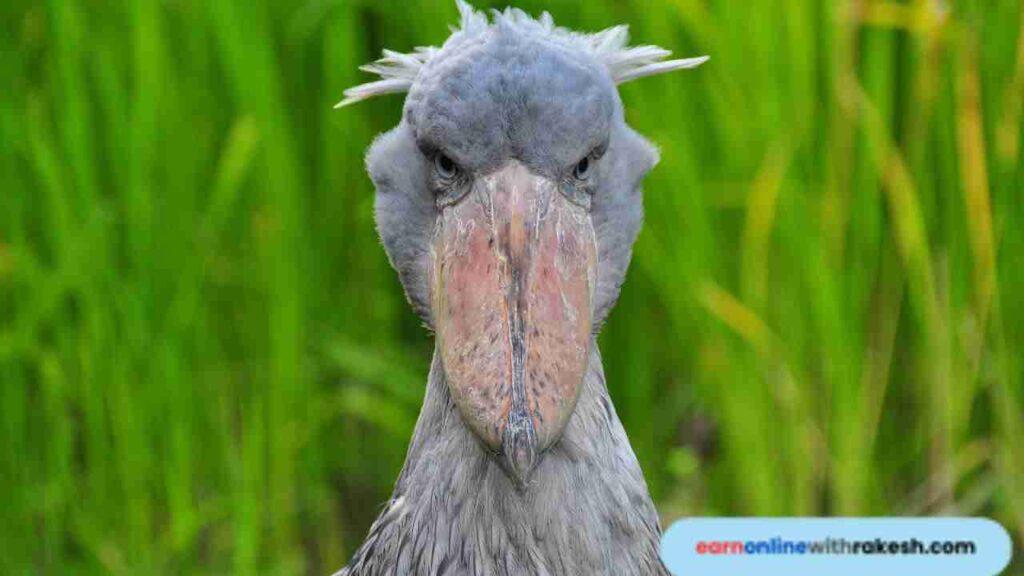Shoebill: human-sized African bird – In the vast marshes and swamps of East Africa resides a truly enigmatic creature, the Shoebill (Balaeniceps rex). Often mistakenly labeled as a stork, this colossal bird stands as the sole representative of the Balaeniceps genus and is part of the Balaenicipitidae family. Its closest living relatives are pelicans, tracing its ancestry back to the Pelecaniformes order from the end of the Cretaceous period, a remarkable testament to its evolutionary history.
Shoebill: human-sized African bird – A Graceful Killer of Crocodiles and Kin

Majestic Physique and Ambush Predation: Unveiling the Shoebill’s Formidable Nature
The shoebill, a living testament to avian magnificence, stands out not only for its towering height, reaching up to an impressive 5 feet, but also for its awe-inspiring physical features that grant it a prehistoric allure. At the forefront of these features is its commanding, sharp-edged bill, measuring a remarkable 1 foot in length and securing its position as the third-largest bird beak globally. This colossal bill, in conjunction with the bird’s long and slender legs, equips the shoebill with the tools it needs to thrive as a formidable ambush predator.
ALSO READ : Revival of Rhinos in Assam : A Triumph in Wildlife Conservation
1. Prehistoric Appearance: The shoebill’s physical appearance evokes a sense of prehistoric mystique, captivating observers with its towering stature and distinctive features. Its appearance often draws comparisons to a bygone era, echoing the grandeur of ancient avian forms that once graced the Earth.
2. Formidable Bill and Ambush Strategy: The defining feature of the shoebill is undoubtedly its massive bill, which serves as a multifunctional tool for survival. This sharp-edged, elongated beak is not merely a visual spectacle but a crucial element in the bird’s predatory arsenal. The shoebill employs an ambush strategy, standing motionless for extended periods in the marshes and swamps it calls home.
3. Ambush Predation Technique: As a patient and skilled hunter, the shoebill relies on its ability to remain motionless, seamlessly blending into its swampy surroundings. When the opportune moment arises, it swiftly lunges forward with remarkable speed and precision, seizing unsuspecting prey in its powerful bill. This hunting technique, captured in the 2015 study published in the Journal of African Ornithology, sheds light on the bird’s exceptional adaptability to its environment.
4. Diverse Prey Selection: The shoebill’s diet encompasses a diverse range of aquatic creatures dwelling in its habitat. The 2015 study underscores the bird’s penchant for catfish, constituting approximately 71% of its meals. Yet, the shoebill is not limited to a single prey type; it displays remarkable versatility by preying on eels, snakes, and even baby crocodiles. This eclectic dietary choice further emphasizes the bird’s adaptability and ecological importance in maintaining a balanced ecosystem.
5. Contribution to Ecological Balance: Beyond its visual and predatory prowess, the shoebill plays a crucial role in preserving the ecological equilibrium of its habitat. By regulating the populations of various aquatic species through its selective predation, the shoebill contributes to the health and sustainability of the wetland ecosystems it inhabits.
In unraveling the physical magnificence and predatory strategies of the shoebill, we gain a profound appreciation for the intricate ways in which this avian marvel has evolved to thrive in its unique environment. The challenges it faces in the wild underscore the importance of conservation initiatives to ensure the continued existence of this awe-inspiring species.
Reproductive Behavior and Intricate Sibling Dynamics:
The reproductive life of the shoebill is a fascinating and intricate journey, offering insights into the challenges and survival strategies of this remarkable species. Despite their mostly solitary nature, shoebills engage in monogamous breeding pairs, forming strong bonds with a single partner. This partnership plays a pivotal role in the continuation of their lineage, marked by a series of unique behaviors and complex interactions.
1. Monogamous Breeding Pairs: Shoebills, known for their solitary habits, come together in monogamous pairs during the breeding season. These pairs form a cooperative unit, sharing responsibilities such as nest-building, incubation, and chick-rearing. This cooperative approach underscores the significance of the bond between the mates in ensuring the successful continuation of their genetic line.
2. Clutch Size and Reproductive Investment: Breeding pairs invest significantly in the reproduction process, laying up to three eggs in a single clutch. This behavior is indicative of their dedication to ensuring the survival of their offspring. However, the reproductive strategy also sets the stage for a fierce competition among siblings, where only the strongest and most resourceful chick typically prevails.
3. Sibling Rivalry and Cannibalism: The journey from hatching to adulthood for shoebill chicks is marked by intense sibling rivalry, a phenomenon that has captivated researchers and wildlife enthusiasts alike. While the parents invest heavily in nurturing their brood, the harsh reality is that the competition for resources is fierce. The larger, first-born chick often asserts dominance through aggression, outcompeting its smaller siblings for food.
Instances of cannibalism among shoebill chicks have been observed and documented, further emphasizing the stark survival instincts ingrained in these remarkable birds. This dark aspect of their behavior, highlighted in a clip from the BBC David Attenborough series “Africa,” portrays the ruthless nature of the sibling rivalry within shoebill families. The older, dominant chick may resort to biting and aggression, and when the mother returns to the nest, she exhibits little to no care for the smaller, struggling offspring.
4. Evolutionary Significance: This complex reproductive and behavioral strategy, while seemingly brutal, holds evolutionary significance. The survival of the fittest ensures that only the strongest and most adaptable individuals contribute to the gene pool, potentially enhancing the species’ overall resilience to environmental challenges.
Understanding the intricate dynamics of shoebill reproduction sheds light on the delicate balance between parental investment, sibling rivalry, and the inherent struggle for survival. Conservation efforts must consider these aspects to ensure the continued resilience of the shoebill population in the face of mounting threats.
Conservation Challenges and Ongoing Threats:
The shoebill, with its remarkable features and captivating behaviors, stands at the precipice of a conservation crisis. The International Union for the Conservation of Nature’s Red List has classified this magnificent bird as ‘vulnerable,’ underscoring the pressing need for concerted conservation efforts. Alarming estimates suggest that only 5,000 to 8,000 individuals of this unique species remain, intensifying concerns about its long-term survival.
1. Habitat Loss: One of the foremost challenges threatening the shoebill’s existence is the relentless loss of its natural habitat. The marshes and swamps of East Africa, vital ecosystems for the shoebill’s survival, are increasingly encroached upon by human activities such as agriculture, infrastructure development, and urbanization. As these wetlands diminish, the bird’s primary hunting and nesting grounds are eroded, leaving it more vulnerable to extinction.
2. Human Activities: The surge in human activities in East Africa poses a direct threat to the shoebill. Disturbances caused by human presence, including tourism, fishing, and settlement expansion, disrupt the bird’s natural behavior and breeding patterns. Moreover, the inadvertent destruction of nests during these activities exacerbates the challenges faced by breeding pairs and their offspring, contributing to the decline in their numbers.
3. Climate Change: The impacts of climate change further compound the challenges for the shoebill. Alterations in weather patterns, shifts in temperature, and changes in precipitation can affect the availability of prey, potentially disrupting the bird’s food sources. Additionally, rising sea levels and extreme weather events can exacerbate the vulnerability of the shoebill’s habitat, pushing this species closer to the brink of extinction.
Conservation Initiatives: In light of these formidable challenges, conservation initiatives are crucial to safeguarding the shoebill’s future. Collaborative efforts between local communities, governments, and international organizations are essential to address the root causes of habitat loss and mitigate the impact of human activities. Conservationists are working to establish protected areas, raise awareness about the importance of preserving the shoebill’s habitat, and implement sustainable practices to ensure the coexistence of the bird and local communities.
Shoebill FAQs: Unveiling the Mysteries of Africa’s Shoebill: human-sized African bird
1. What makes the Shoebill unique?
- The Shoebill stands out with its human-sized frame, menacing prehistoric appearance, and the distinction of possessing the third-largest bird beak globally.
2. How does the Shoebill hunt?
- Armed with a 1-foot-long sharp-edged bill, the Shoebill is a formidable ambush predator. Its hunting strategy involves standing still in swamps before lunging forward to grab unsuspecting prey, including catfish, eels, snakes, and even baby crocodiles.
3. What is the Shoebill’s reproductive behavior?
- Despite being mostly solitary, Shoebills form monogamous breeding pairs. Breeding pairs lay up to three eggs in a clutch, but fierce sibling rivalry often results in only the larger first-born chick surviving to adulthood.
4. How does sibling rivalry manifest in Shoebill families?
- Sibling rivalry among Shoebills involves aggression and even cannibalism, as highlighted in a BBC David Attenborough series. The larger first-born chick often dominates, either outcompeting its siblings for food or resorting to lethal measures.
5. What are the conservation challenges faced by the Shoebill?
- The Shoebill faces a dire conservation status, categorized as vulnerable on the International Union for the Conservation of Nature’s Red List. Threats include habitat loss due to human activities, increasing urbanization, and climate change impacts, endangering the survival of this captivating species.
6. Why is the Shoebill important for its ecosystem?
- Beyond its predatory prowess, the Shoebill contributes to ecological balance by regulating the populations of various aquatic species in its habitat, maintaining a harmonious wetland ecosystem.
7. How many Shoebills are estimated to remain in the wild?
- The population of Shoebills is estimated to be between 5,000 to 8,000 individuals, underlining the urgent need for conservation initiatives to secure the future of this unique African bird.
Conclusion: Shoebill: human-sized African bird
As we marvel at the awe-inspiring nature of the shoebill, it is essential to recognize the urgency in addressing its conservation needs. With a unique evolutionary history and captivating behaviors, the shoebill symbolizes the diverse wonders of the natural world. The responsibility lies on us to ensure its continued existence, fostering awareness and conservation efforts to preserve this giant bird for future generations.















